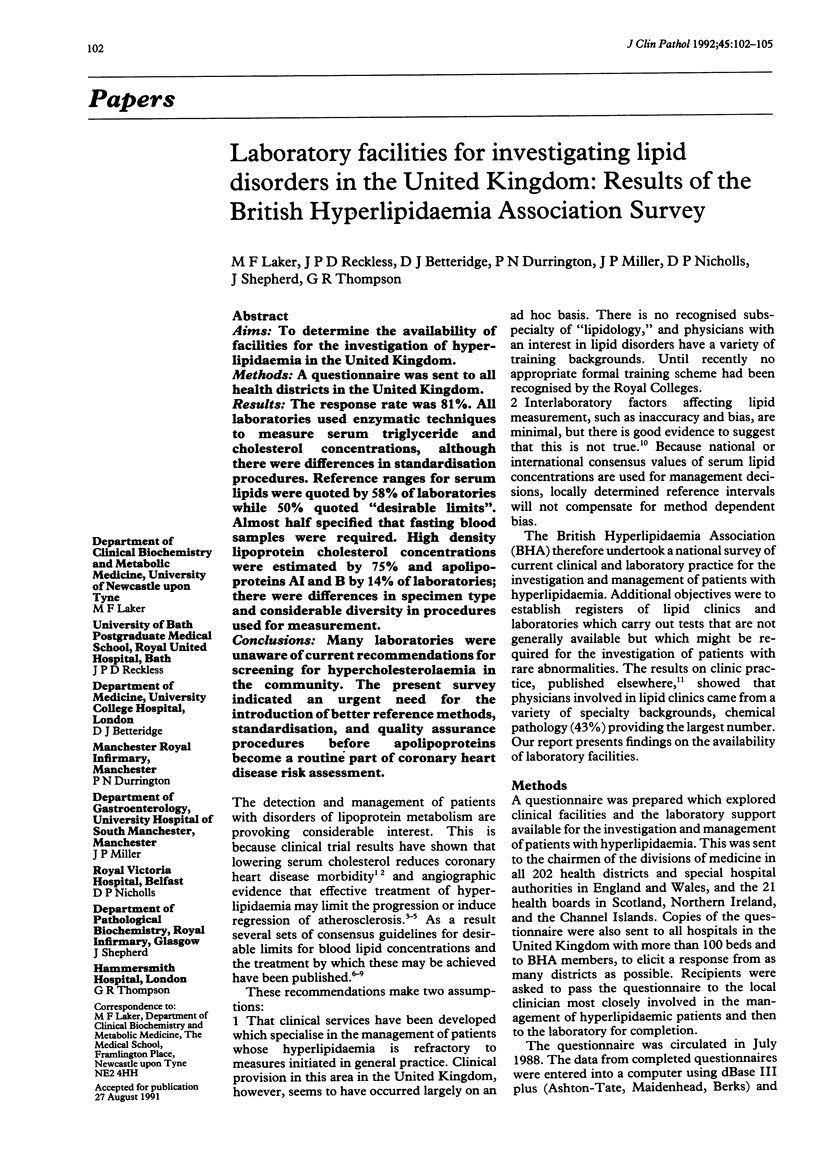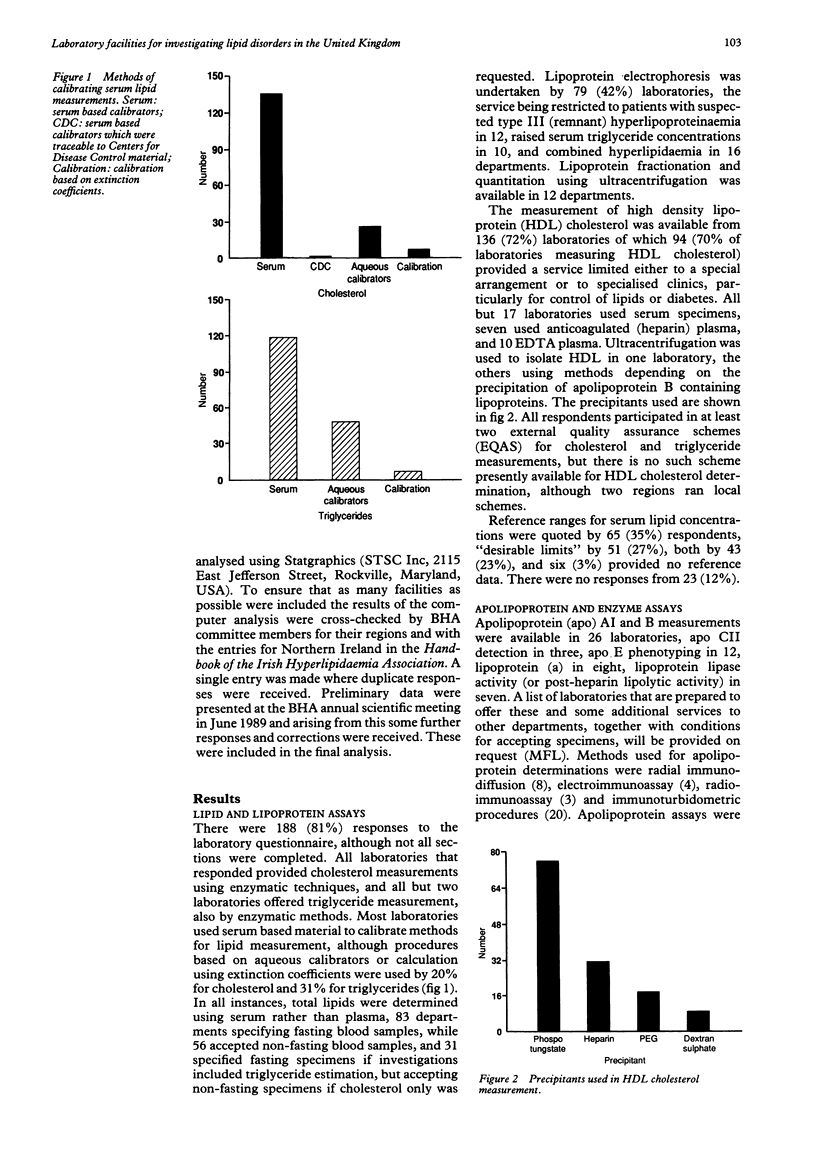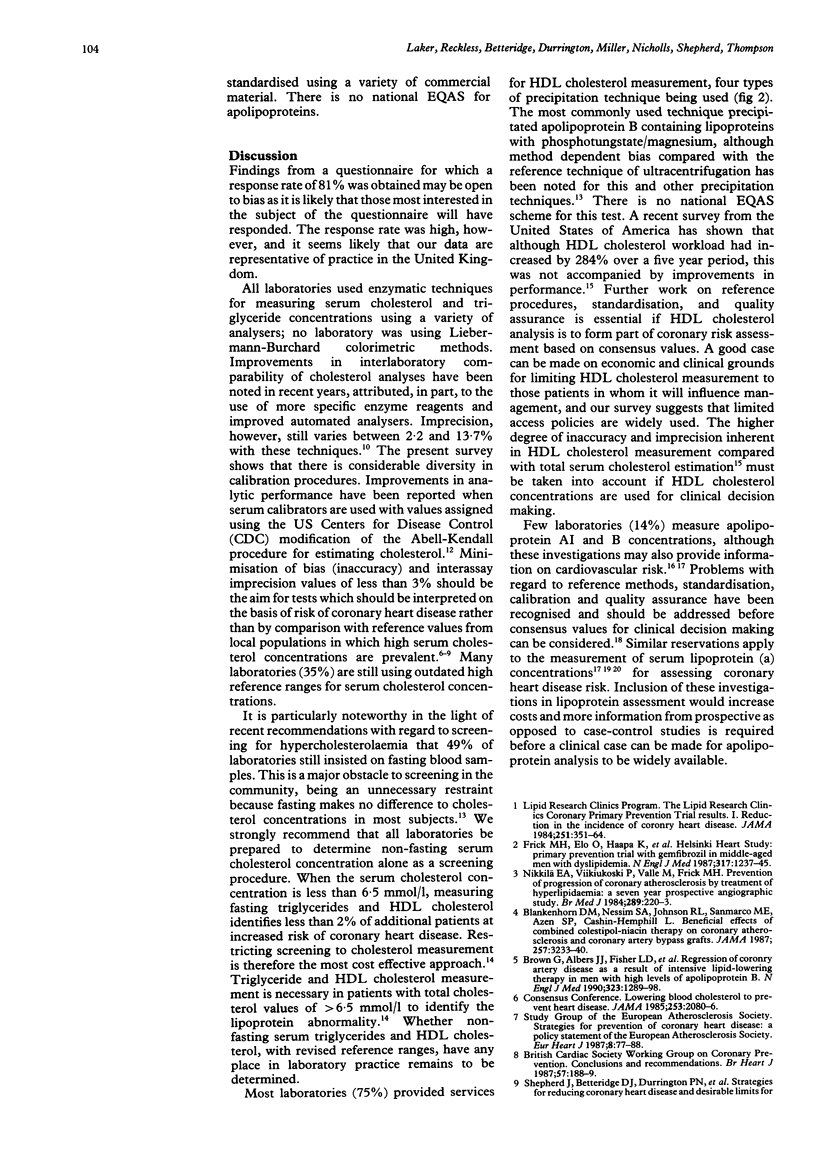Abstract
AIMS: To determine the availability of facilities for the investigation of hyperlipidaemia in the United Kingdom. METHODS: A questionnaire was sent to all health districts in the United Kingdom. RESULTS: The response rate was 81%. All laboratories used enzymatic techniques to measure serum triglyceride and cholesterol concentrations, although there were differences in standardisation procedures. Reference ranges for serum lipids were quoted by 58% of laboratories while 50% quoted "desirable limits". Almost half specified that fasting blood samples were required. High density lipoprotein cholesterol concentrations were estimated by 75% and apolipoproteins AI and B by 14% of laboratories; there were differences in specimen type and considerable diversity in procedures used for measurement. CONCLUSIONS: Many laboratories were unaware of current recommendations for screening for hypercholesterolaemia in the community. The present survey indicated an urgent need for the introduction of better reference methods, standardisation, and quality assurance procedures before apolipoproteins become a routine part of coronary heart disease risk assessment.
Full text
PDF



Selected References
These references are in PubMed. This may not be the complete list of references from this article.
- Blankenhorn D. H., Nessim S. A., Johnson R. L., Sanmarco M. E., Azen S. P., Cashin-Hemphill L. Beneficial effects of combined colestipol-niacin therapy on coronary atherosclerosis and coronary venous bypass grafts. JAMA. 1987 Jun 19;257(23):3233–3240. [PubMed] [Google Scholar]
- Boerma G. J., Jansen A. P., Jansen R. T., Leijnse B., van Strik R. Minimizing interlaboratory variation in routine assays of serum cholesterol through the use of serum calibrators. Clin Chem. 1986 Jun;32(6):943–947. [PubMed] [Google Scholar]
- Brown G., Albers J. J., Fisher L. D., Schaefer S. M., Lin J. T., Kaplan C., Zhao X. Q., Bisson B. D., Fitzpatrick V. F., Dodge H. T. Regression of coronary artery disease as a result of intensive lipid-lowering therapy in men with high levels of apolipoprotein B. N Engl J Med. 1990 Nov 8;323(19):1289–1298. doi: 10.1056/NEJM199011083231901. [DOI] [PubMed] [Google Scholar]
- Donahue R. P., Orchard T. J., Stein E. A., Kuller L. H. Apolipoproteins AI, AII and B in young adults: associations with CHD risk factors. The Beaver County experience. J Chronic Dis. 1986;39(10):823–830. doi: 10.1016/0021-9681(86)90084-6. [DOI] [PubMed] [Google Scholar]
- Durrington P. N., Ishola M., Hunt L., Arrol S., Bhatnagar D. Apolipoproteins (a), AI, and B and parental history in men with early onset ischaemic heart disease. Lancet. 1988 May 14;1(8594):1070–1073. doi: 10.1016/s0140-6736(88)91895-8. [DOI] [PubMed] [Google Scholar]
- Frick M. H., Elo O., Haapa K., Heinonen O. P., Heinsalmi P., Helo P., Huttunen J. K., Kaitaniemi P., Koskinen P., Manninen V. Helsinki Heart Study: primary-prevention trial with gemfibrozil in middle-aged men with dyslipidemia. Safety of treatment, changes in risk factors, and incidence of coronary heart disease. N Engl J Med. 1987 Nov 12;317(20):1237–1245. doi: 10.1056/NEJM198711123172001. [DOI] [PubMed] [Google Scholar]
- MBewu A. D., Durrington P. N. Lipoprotein (a): structure, properties and possible involvement in thrombogenesis and atherogenesis. Atherosclerosis. 1990 Nov;85(1):1–14. doi: 10.1016/0021-9150(90)90177-k. [DOI] [PubMed] [Google Scholar]
- McMillan T. A., Warnick G. R. Interlaboratory proficiency survey of cholesterol and high-density lipoprotein cholesterol measurement. Clin Chem. 1988 Aug;34(8):1629–1632. [PubMed] [Google Scholar]
- Neil H. A., Mant D., Jones L., Morgan B., Mann J. I. Lipid screening: is it enough to measure total cholesterol concentration? BMJ. 1990 Sep 22;301(6752):584–587. doi: 10.1136/bmj.301.6752.584. [DOI] [PMC free article] [PubMed] [Google Scholar]
- Nikkilä E. A., Viikinkoski P., Valle M., Frick M. H. Prevention of progression of coronary atherosclerosis by treatment of hyperlipidaemia: a seven year prospective angiographic study. Br Med J (Clin Res Ed) 1984 Jul 28;289(6439):220–223. doi: 10.1136/bmj.289.6439.220. [DOI] [PMC free article] [PubMed] [Google Scholar]
- Seed M., Hoppichler F., Reaveley D., McCarthy S., Thompson G. R., Boerwinkle E., Utermann G. Relation of serum lipoprotein(a) concentration and apolipoprotein(a) phenotype to coronary heart disease in patients with familial hypercholesterolemia. N Engl J Med. 1990 May 24;322(21):1494–1499. doi: 10.1056/NEJM199005243222104. [DOI] [PubMed] [Google Scholar]
- Shepherd J., Betteridge D. J., Durrington P., Laker M., Lewis B., Mann J., Miller J. P., Reckless J. P., Thompson G. R. Strategies for reducing coronary heart disease and desirable limits for blood lipid concentrations: guidelines of the British Hyperlipidaemia Association. Br Med J (Clin Res Ed) 1987 Nov 14;295(6608):1245–1246. doi: 10.1136/bmj.295.6608.1245. [DOI] [PMC free article] [PubMed] [Google Scholar]


